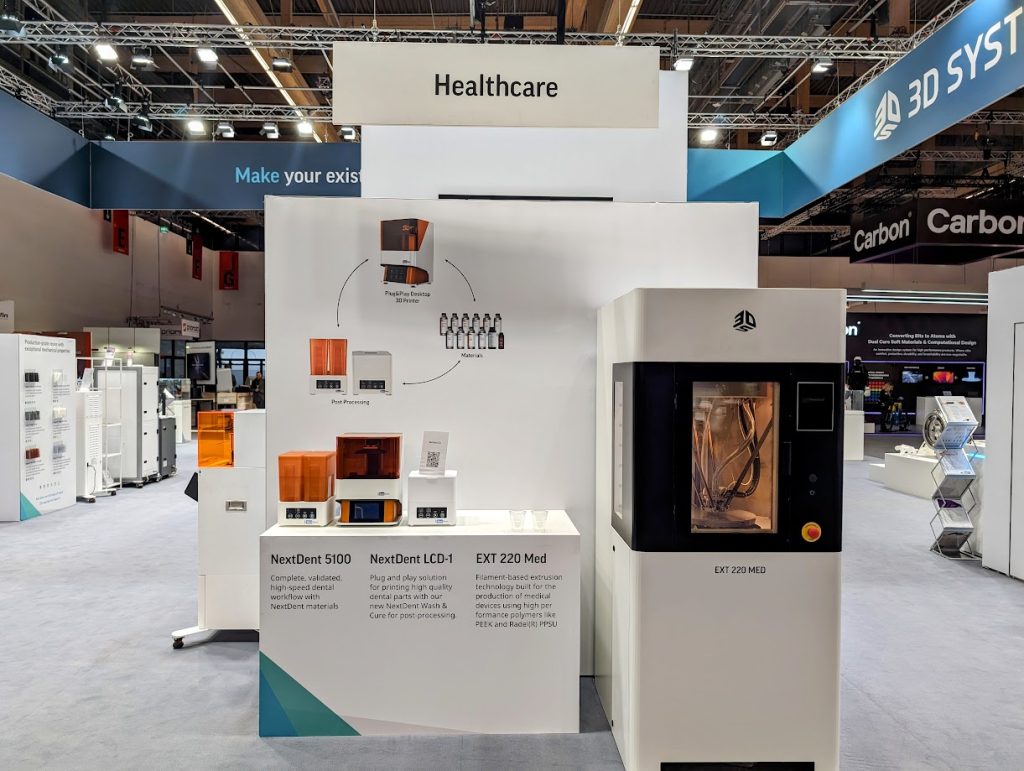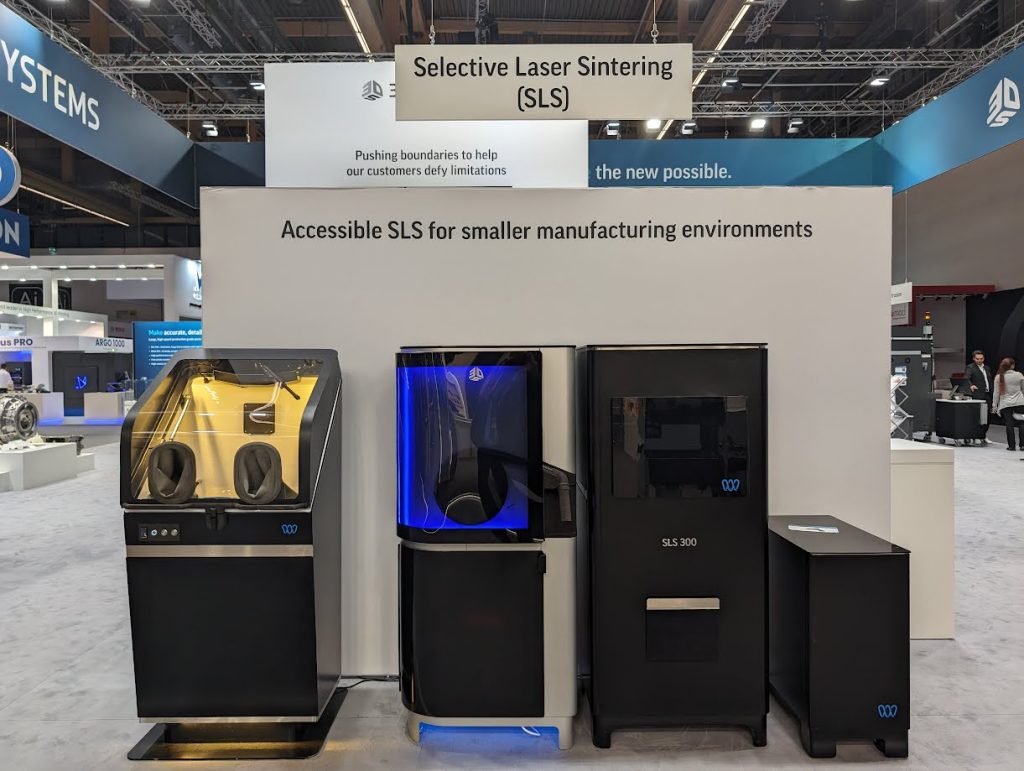At Formnext 2023, I was given a tour of the 3D Systems booth by Marty Johnson, Vice President, Product and Technical Fellow at 3D Systems. The tour highlighted the company’s latest innovations, including a new platform previewed at the event.
Johnson showcased the EXT 1070 Titan Pellet, noting its unique feature as a pellet extruder capable of handling commercial pellets like PC ABS, regular glass fill, carbon polycarbonate, and others. This technology allows for smooth finishes on plastic parts, beneficial for creating large components like car jigs and fixtures with accurate data. Johnson emphasized the speed and precision of this method, which is also useful for vacuum-forming tooling.
A significant point of discussion was the affordability and efficiency of these new technologies in transforming transportation. Johnson illustrated this by referencing a part made from glass-filled polycarbonate pellets, emphasizing the use of high-performance plastics. Another example was a radar mounting mast made from carbon cell ABS, which was gel-coated post-production for a smooth finish. This part, notable for its lightweight and aesthetic quality, represented the advancements in 3D printing technology for low-volume production, offering an alternative to more traditional methods like metal machining.
Johnson pointed out that using these new technologies could significantly reduce both time and expense in manufacturing processes, especially for low-volume, high-precision items, marking a shift in production methodologies towards more efficient and adaptable solutions.
Our next stop took in some of 3D Systems’ latest advancements in 3D printing technology for the medical field.
Johnson introduced the EXT 220 MED, previously known as the Kumovis R1, a medical printer notable for its cleanroom-rated interior. He highlighted its significant role in creating a cranial implant, emphasizing the printer’s capability to 3D print PEEK, which is crucial for such medical applications. This technology represents a significant leap in medical 3D printing, offering new possibilities in patient-specific treatments.
Discussing the Delta setup of the printer, Johnson explained its advantages in terms of freedom of movement and accuracy, which are essential for producing complex medical parts like spinal cages. The Delta setup also provides flexibility due to fewer electronics on the print head, which is beneficial in a high-temperature environment inside the printer.

New PSLA 270 combines SLA and Figure 4 Technologies
Johnson then previewed the PSLA 270, a new model combining features from SLA and Figure 4 technologies. This printer boasts a dual-projector system, a VAT at the bottom, and improvements in speed, accuracy, and repeatability. Johnson mentioned the successful use of their Figure 4 PRO-BLK 10 material, noting its rigidity, quick print speeds, and impact resistance. He compared its properties to PMMA acrylic plastic, highlighting its suitability for various applications.
A key focus of the discussion was the long-term stability of these materials. Johnson stressed that their materials are formulated for longevity, with minimal to low changes in elongation at break tested out to 8 years indoors, and also tested to 1.5 to 2 years outdoors. This stability is critical in choosing materials for industrial and medical applications, as it ensures the durability and reliability of the printed parts.
Johnson revealed that the new PSLA 270 printer model, previewed at the event, is expected to be commercially available mid-next year. He emphasized the importance of fine-tuning the product for a successful launch, noting the printer’s unique capabilities.
Product lines are still being finalized when asked about the selection of materials for the new printer, particularly the NextDent material portfolio. He expressed confidence in the Figure 4 material portfolio, citing its diversity, including materials for medical sterilization and high-durability applications like Figure 4 FLEX-BLK 20.
Highlighting 3D Systems’ extensive experience in software development and projector-based printing since 2007, which has enabled them to refine pixel manipulation and edge resolution. This expertise, combined with their long-standing process knowledge, specialized hardware, and comprehensive customer support, sets them apart in the industry. He mentioned the company’s Application Innovation Group (AIG), which focuses on solving complex problems, underscoring their ability to deliver speed, accuracy, repeatability, and simplicity in their SLA systems.
The competition is no longer rival 3D printing companies, says Johnson, but 3D Systems is focusing instead on competing with traditional manufacturing processes like injection molding and machining. He emphasized the goal of capturing high-value applications by leveraging their technology’s ability to produce complex geometries and materials, a strategic shift from competing solely within the 3D printing industry to challenging conventional manufacturing methods. This approach reflects 3D Systems’ broader vision to transform production processes across various industries.
3D printing: a competitive advantage
Discussing medical applications, particularly in surgical planning, Johnson showcased the SLA 750 Dual, an advanced 3D printer upgraded from a single laser to a dual laser system a year ago. He stressed the importance of this machine, saying, “When I talk about SLA, we’ve been doing it since the very beginning,” highlighting 3D Systems’ expertise in materials and machine control.
One of the key materials discussed was the Accura AMX Tough FR-V0 Black, a flame-retardant material boasting exceptional toughness, a rarity in flame-retardant materials. This material and 3D Sprint, 3D Systems advanced software, allows for enhanced speed, accuracy, and repeatability.
Johnson also mentioned the use of these technologies in high-pressure environments such as Formula 1, highlighting the relevance of their printing capabilities in producing high-performance parts quickly. He provided an example of how the dual laser system significantly reduces printing time. For instance, a part that would take 32 hours on a comparative system (Pro X 800) could be printed in just 25 hours with their single laser system and even faster with the dual system.
These advancements mark a notable shift in the efficiency and practicality of 3D printing technology for various high-demand applications.
Advanced Metal AM and Accessible SLS for smaller manufacturing environments
I also saw 3D Systems’ advanced metal 3D printing technologies and accessible SLS (Selective Laser Sintering) systems.
The DMP Flex 350 Triple is a metal printer with unique features, including an auto-latching door and enhanced heat and gas flow balance for optimal productivity. He explained, “The system goes to 350 by 350 by 350 mm. You’re able to take advantage of those three lasers.” The DMP Flex 350 Triple’s design allows for efficient use of material, crucial given the high cost of metal materials, and aims to achieve first print success with a focus on longevity and reusability.
Johnson also mentioned the market’s growing interest in smaller-scale SLS technology, represented on the 3D Systems’ booth by the SLS 300 and the accompanying ecosystem of Atmosphere Generator, Water Jet Cabinet, and the forthcoming Powder Recycling Station (PRS).
Johnson noted the system’s appeal to newcomers and larger companies looking to scale their printing capabilities. He said, “It’s a way to help scale their print lab within their company.” Discussing the printer’s accessibility, Johnson highlighted its appeal to experts and non-expert users, saying, “It’s not only accessible to more people, but it’s accessible to non-expert users to be able to run in their center.” The system’s compactness and integrated components, including the aforementioned nitrogen generator and Powder Recycling Station, make it an efficient solution for maximizing lab space. The system is designed for ease of use and efficiency, with software that optimizes print jobs within the machine’s capabilities.
The conversation at Formnext 2023 showcased 3D Systems’ commitment to advancing 3D printing technology, making it more accessible and efficient for a wider range of users and applications. Johnson’s insights highlight the company’s focus on innovation, user-friendliness, and market expansion in the 3D printing industry.

Read all the 3D Printing Industry coverage from Formnext 2023.
What does the future of 3D printing for the next ten years hold?
What engineering challenges will need to be tackled in the additive manufacturing sector in the coming decade?
To stay up to date with the latest 3D printing news, don’t forget to subscribe to the 3D Printing Industry newsletter or follow us on Twitter, or like our page on Facebook.
While you’re here, why not subscribe to our Youtube channel? Featuring discussion, debriefs, video shorts, and webinar replays.
Are you looking for a job in the additive manufacturing industry? Visit 3D Printing Jobs for a selection of roles in the industry.
Featured image shows 3D Systems DMP Flex 350 Triple Metal 3D Printer. Photo by Michael Petch.



